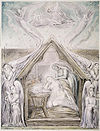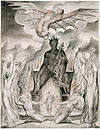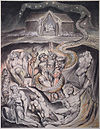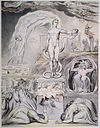User:Lithoderm/William Blake and Enlightenment Philosophy
I'll be using this page as a general Blake sandbox.
Possible plagiarism in William Blake#Dante's Inferno
[edit]|
The commission for Dante's Inferno came to Blake in 1826 through Linnell, with the ultimate aim of producing a series of engravings. Blake's death in 1827 would cut short the enterprise, and only a handful of the watercolours were completed, with only seven of the engravings arriving at proof form. Even so, they have evoked praise: "The mastery of watercolor has reached an even higher level than before, and is used to extraordinary effect in differentiating the atmosphere of the three states of being in the poem." Blake's illustrations of the poem are not merely accompanying works, but rather seem to critically revise, or furnish commentary on, certain spiritual or moral aspects of the text. In illustrating Paradise Lost, for instance, Blake seemed intent on revising Milton's focus on Satan as the central figure of the epic; for example, in Satan Watching the Endearments of Adam and Eve (1808), Satan occupies an isolated position at the picture's top, with Adam and Eve centered below. As if to emphasise the effects of the juxtaposition, Blake has shown Adam and Eve caught in an embrace, whereas Satan may only onanistically caress the serpent, whose identity he is close to assuming. In this instance, because the project was never completed, Blake's intent may itself be obscured. Some indicators, however, bolster the impression that Blake's illustrations in their totality would themselves take issue with the text they accompany: In the margin of Homer Bearing the Sword and His Companions, Blake notes, "Every thing in Dantes Comedia shews That for Tyrannical Purposes he has made This World the Foundation of All & the Goddess Nature & not the Holy Ghost." Blake seems to dissent from Dante's admiration of the poetic works of the ancient Greeks, and from the apparent glee with which Dante allots punishments in Hell (as evidenced by the grim humour of the cantos). At the same time, Blake shared Dante's distrust of materialism and the corruptive nature of power, and clearly relished the opportunity to represent the atmosphere and imagery of Dante's work pictorially. Even as he seemed to near death, Blake's central preoccupation was his feverish work on the illustrations to Dante's Inferno; he is said to have spent one of the very last shillings he possessed on a pencil to continue sketching. |
Once Blake had finished work on the Job engravings Linnell gave him the ambitious task of making 100 watercolors for Dante's Divine Comedy (Butlin 812), with the aim of producing also a series of engravings. The work was not completed before his death in 1827. Only a small number of the Dante watercolors are finished; some are barely sketched in, and only seven engravings reached proof form. Even so the Dante watercolors are among Blake's richest achievements, engaging fully with the problem of illustrating a poem of such complexity. The mastery of watercolor has reached an even higher level than before, and is used to extraordinary effect in differentiating the atmosphere of the three states of being in the poem. ... Such an inconclusive ending, as well as the remark penciled on Homer Bearing the Sword, and His Companions (7) (Butlin 812 7): "Every thing in Dante's Commedia shews That for Tyrannical Purposes he has made This World the Foundation of All the Goddess Nature & not the Holy Ghost" (E 689), mark Blake's dissent from Dante's admiration for the poets of pagan Greece, and from the vengefulness of Dante's Hell...Yet there are also abundant signs of Blake's relish for Dante's imagery and creation of atmosphere, and also sympathy for Dante's hatred of the corruption of power and of materialism. |
Blake and Enlightenment Philosophy
[edit]Blake stood opposed to the predominant Enlightenment views of his day because what he saw as Newton's dead atomic machine of a universe was opposed to his visionary religious and artistic views. Blake believed that paintings which naturalistically depict the fall of light upon objects were products entirely of the "vegetative eye" and not the imagination. He railed against it in his marginalia to Joshua Reynolds he Blake saw Locke and Newton as "the true progenitors of Sir Joshua Reynolds' aesthetic"(285). The popular taste in the England of that time for such paintings was satisfied with mezzotints, prints produced by a process that created an image from thousands of tiny dots upon the page. Blake saw an analogy between this and Newton's particle theory of light, and significantly never used the technique.
Blake's marginalia on The Complete Works of Sir Joshua Reynolds, P 204. My notion of nature comprehends . . . also the . . .
human mind and imagination.
<Here is a Plain Confession that he Thinks Mind &
Imagination not to be above the Mortal & Perishing Nature. Such
is the End of Epicurean or Newtonian Philosophy it is Atheism>
I turn my eyes to the Schools & Universities of Europe
And there behold the Loom of Locke whose Woof rages dire
Washd by the Water-wheels of Newton. black the cloth
In heavy wreathes folds over every Nation; cruel Works
Of many Wheels I view, wheel without wheel, with cogs tyrannic
Moving by compulsion each other: not as those in Eden: which
Wheel within Wheel in freedom revolve in harmony & peace.
To Venetian Artists
[edit]That God is Colouring Newton does shew
And the devil is a Black outline all of us know
Perhaps this little Fable may make us merry
A dog went over the water without a wherry
A bone which he had stolen he had in his mouth
He cared not whether the wind was north or south
As he swam he saw the reflection of the bone
This is quite Perfection, one Generalizing Tone 8
Outline Theres no outline Theres no such thing
All is Chiaro Scuro Poco Piu its all Colouring
Snap. Snap! he has lost shadow & substance too
He had them both before now how do ye do
A great deal better than I was before
Those who taste colouring love it more & more 11
William Blake's Illustrations to The Divine Comedy
[edit]William Blake's Illustrations to the Divine Comedy encompass more than 100 watercolours, drawings, and engravings he began work on in 1824 and left in varying stages of completion upon his death in 1827.
Blake's view of Dante
[edit]Blake's annotations (c. 1800) of Henry Boyd's translation of the Inferno display a critical approach to the work. Blake also owned a copy of Henry Cary's 1814 translation of The Divine Comedy, and taught himself Italian to read the original.[1]
Development
[edit]Blake's work began in 1824 with the commission of John Linell, who paid one pound a week for Blake's work beginning in December of the next year. By 1826, he had begun to engrave the designs in copper. Of the engravings only seven were completed before Blake died on 12 August 1827.[2]
Technique
[edit]References
[edit]The Book of Los
[edit]The Book of Los (1795), is a prophetic book by William Blake. It is a retelling of The Book of Urizen from the point of view of Los. It exists only in one complete copy, which is in the collection of the British Museum. The book is unusual in that its copper plates were printed entirely by the intaglio process, rather than relief etching, which was used for the other prophetic books.
References
[edit]- Entry in S. Foster Damon's Blake Dictionary
- Upload me!
An Island in the Moon
[edit]Certainty for the position of a particular illustration in a particular point in the sequence can be measured on a scale from 1 to 4, with 1 being no certainty whatsoever, and 4 being the greatest certainty. Certainty for a particular illustration is the inverse of the number of different locations in which it is placed (or the number of different scholars that agree on it being in a single location), and certainty for a given location is the inverse of the number of different illustrations that have been proposed for that location (or the number of scholars that agree that a certain illustration should be placed there).
(This is getting awfully OCD)
Key
[edit]- The Descent of Peace = D
- The Annunciation to the Shepherds = A
- The Old Dragon = Ol
- The Overthrow of Apollo and the Pagan Gods = Ov
- The Flight of Moloch = F
- The Night of Peace = N
Certainty v1
[edit]Certainty per location. Notice that certainty is correlated to the location of the print in the sequence- the location of prints closer to the center is less certain.
- 4
- 3
- 1
- 2
- 2
- 3
Certainty v2
[edit]Certainty per illustration.
D=4
A=3
Ol=2
Ov=1
F=2
N=3
Ranking for the previous
In order from most certain to least certain
- D (100 %)
- A & N (75 %)
- Ol & F (50 %)
- Ov (25 %)
Certainty v3
[edit]Here the digit indicates the # of scholars who place the print in that location. Attempt at combining the previous two.
- D=4
- A=3, N=1
- F=1, A=1, Ol= 1, Ov=1
- F=2, Ol=1, Ov=1
- Ol=2, Ov=1, F=1
- N=3, Ov=1
This shows us that the most probable sequence, from the available data, is thus:
- D
- A
- Ov
- F
- Ol
- N
These results coincidentally correspond to the sequence adopted by Behrendt and Werner. Of course, this is based solely on existing numbers, without considering the persuasiveness of the argument advanced by each scholar or any original analysis of traits intrinsic to the artworks.
Displayed together with certainty percentage
- D (100 %)
- A (75 %)
- Ov (25 %)
- F (50 %)
- Ol (50%)
- N (75 %)
Sequence v1
[edit]Sequence v2
[edit]Already existing articles
[edit]Illustrations of the Book of Job
[edit]needs...
- better sectioning, expansion in most sections
- an explanation of blake's philosophy of art and how it affected his technique...
- a section on the New Zealand set (see Butlin)
- all of the illustrations:
- uploaded to commons
- In a table in the article, ala the illustrations to OtMoCN
The Tyger
[edit]Looks like the entire substance of the article has been removed, although it was generally correct. Needs major work, lest it be shmoopified, especially as this is perhaps Blake's best known work.
Shmoop
[edit]Speaking of Shmoop, it looks like single purpose accounts are Shmooping all over various articles again. I would have a list of these accts, if I still cared. But supposing I did, it would run:
Other
[edit]
The image to the right is very curious. I wonder if it was copied by one of the "Ancients" after Blake's original design, which was far more forceful.
- Aha, according to the British Museum, it's not in Butlin, so it likely is not by Blake.






